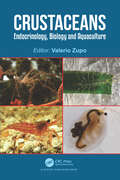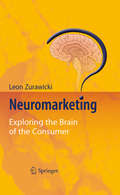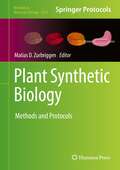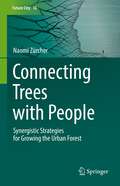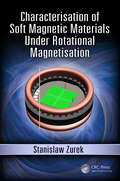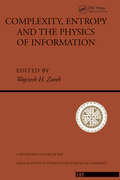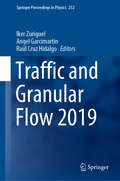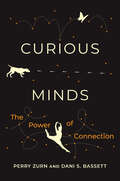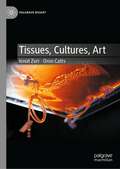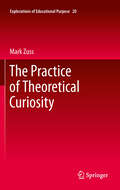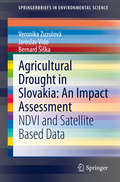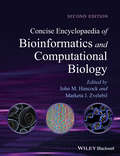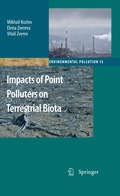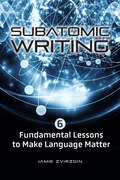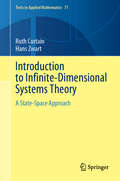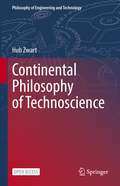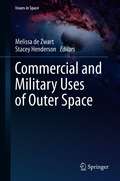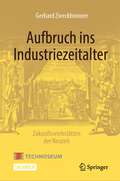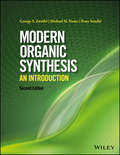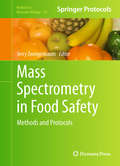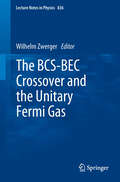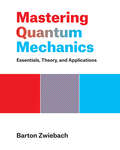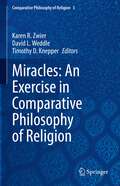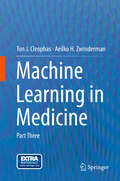- Table View
- List View
Crustaceans: Endocrinology, Biology and Aquaculture
by Valerio ZupoAnyone who attempts to study crustaceans soon realizes that there are many science fields involved. As a major subphylum of Arthropods—the largest phylum in the animal kingdom—crustaceans exhibit an extraordinary diversity of taxa, shapes, physiology and styles of life. These invertebrates play key ecological roles in all aquatic environments, while only a few species are adapted to sub-aerial and humid environments. Their evolutionary success is not only due to a wide set of morphological and biological adaptations, but also because of some key features, e.g., their peculiar endocrinology. In addition, crustaceans are characterized by chemical and optical sensors deserving attention because they play important biological roles, linked to chemical ecology issues, and their functioning is impaired by global changes and ocean acidification. Several crustaceans have critical roles in aquatic ecology (e.g., copepods in the plankton, amphipods and isopods in the benthos). Select species are technologically important as "models" for scientific research. Furthermore, aquaculture of several decapod crustaceans is important for providing high protein products to meet the need for nutrition. Understanding the physiology and ecology of crustaceans is important to fulfill these diverse purposes and practical applications. In this book, leading world scientists have pooled their excellence to provide vibrant and expert views of fundamental biological and physiological mechanisms involving crustaceans. To this end, a comprehensive view of crustacean endocrinology and reproductive ecology is provided, along with information about their molecular physiology, adaptations, aquaculture and welfare. In particular, we attempted to span the breadth of their adaptations, presenting behavioral and physiological peculiarities, considering key groups of crustaceans to describe general features and global biodiversity. This book is offered as a tool for students and scientists in various fields of physiological, ecological, biotechnological and aquacultural research.
Neuromarketing
by Leon ZurawickiOver the last 10 years advances in the new field of neuromarketing have yielded a host of findings which defy common stereotypes about consumer behavior. Reason and emotions do not necessarily appear as opposing forces. Rather, they complement one another. Hence, it reveals that consumers utilize mental accounting processes different from those assumed in marketers' logical inferences when it comes to time, problems with rating and choosing, and in post-purchase evaluation. People are often guided by illusions not only when they perceive the outside world but also when planning their actions - and consumer behavior is no exception. Strengthening the control over their own desires and the ability to navigate the maze of data are crucial skills consumers can gain to benefit themselves, marketers and the public. Understanding the mind of the consumer is the hardest task faced by business researchers. This book presents the first analytical perspective on the brain - and biometric studies which open a new frontier in market research.
Plant Synthetic Biology: Methods and Protocols (Methods in Molecular Biology #2379)
by Matias D. ZurbriggenThis volume provides methods on different aspects and applications on plants, algae, photosynthetic bacteria, synthetic construct design, and multiplex cloning. Chapters cover multiple aspects of synthetic metabolic, photosynthetic systems, metabolic and signaling pathways, advanced engineering of metabolic networks, isolation of organelles and co-culture of microorganisms, and methods for the on command manipulation of the relative stability of proteins. Written in the format of the highly successful Methods in Molecular Biology series, each chapter includes an introduction to the topic, lists necessary materials and reagents, includes tips on troubleshooting and known pitfalls, and step-by-step, readily reproducible protocols. Authoritative and cutting-edge, Plant Synthetic Biology: Methods and Protocols aims to be a useful resource for both researchers starting to explore novel experimental avenues as well as for experts willing to expand their portfolio of tools and strategies.
Connecting Trees with People: Synergistic Strategies for Growing the Urban Forest (Future City #16)
by Naomi ZürcherWritten from the perspective of an urban forester and certified arborist, the reader will have a basic understanding of what makes a tree a tree in context to the philosophical and cultural underpinnings of Urban and Community Forestry, and learn how to implement model, time-tested global green practices and initiatives derived from citizen science.
Characterisation of Soft Magnetic Materials Under Rotational Magnetisation
by Stanislaw ZurekThe book presents practical aspects related to the measurement of rotational power loss in soft magnetic materials. The book furthermore focuses on practical aspects of performing such measurements, the associated difficulties as well as solutions to the most common problems. Numerous practical aspects, hands-on experience, and most commonly encountered pitfalls are heavily discussed in the book. The text begins with introduction to magnetism, then follows with definitions of measurement methods of rotational power loss from physical viewpoint. Two chapters describe and detail the various sensors which can be employed for such measurements as well as all the aspects of designing, making, and using a magnetising apparatus. A synthesis of the likely optimal design of a magnetising apparatus is also given, preceded with the full reasoning based on all the research carried out to date. <P><P>Characterisation of Soft Magnetic Materials Under Rotational Magnetisation serves as an excellent starting point for any student having to perform magnetic measurements under rotational magnetisation, but also under 1D, 2D or 3D excitation. Because the methods, sensors, and apparatus are extensively discussed it will also be a great reference for more senior researchers and experts in the field. There is a whole chapter devoted to analysis of measurement uncertainty. This subject is rarely published for magnetic measurements, which makes it more difficult for all researchers to understand the concepts and methodology used in uncertainty estimation. This chapter not only introduces the whole subject, but also provides multiple step-by-step examples which can be easily followed, from very simple cases to much more complex ones. All equations are presented with full SI units which greatly helps in practical application of the presented methodology. Each chapter is written in such a way that it can be studied on its own, so that the reader can focus only on the specific aspects, as required.
Complexity, Entropy And The Physics Of Information (Santa Fe Institute Ser)
by Wojciech H. ZurekA must have for those with a deep commitment to the second law of thermodynamics, entropy, and information theory.
Traffic and Granular Flow 2019 (Springer Proceedings in Physics #252)
by Iker Zuriguel Angel Garcimartín Raúl Cruz HidalgoThis book gathers contributions on a variety of flowing collective systems. While primarily focusing on pedestrian dynamics, they also reflect the latest developments in areas such as vehicular traffic and granular flows and address related emerging topics such as self-propelled particles, data transport, swarm behavior, intercellular transport, and collective dynamics of biological systems. Combining fundamental research and practical applications in the various fields discussed, the book offers a valuable asset for researchers and practitioners alike.
Curious Minds: The Power of Connection
by Perry Zurn Dani S. BassettAn exhilarating, genre-bending exploration of curiosity&’s powerful capacity to connect ideas and people.Curious about something? Google it. Look at it. Ask a question. But is curiosity simply information seeking? According to this exhilarating, genre-bending book, what&’s left out of the conventional understanding of curiosity are the wandering tracks, the weaving concepts, the knitting of ideas, and the thatching of knowledge systems—the networks, the relations between ideas and between people. Curiosity, say Perry Zurn and Dani Bassett, is a practice of connection: it connects ideas into networks of knowledge, and it connects knowers themselves, both to the knowledge they seek and to each other. Zurn and Bassett—identical twins who write that their book &“represents the thought of one mind and two bodies&”—harness their respective expertise in the humanities and the sciences to get irrepressibly curious about curiosity. Traipsing across literatures of antiquity and medieval science, Victorian poetry and nature essays, as well as work by writers from a variety of marginalized communities, they trace a multitudinous curiosity. They identify three styles of curiosity—the busybody, who collects stories, creating loose knowledge networks; the hunter, who hunts down secrets or discoveries, creating tight networks; and the dancer, who takes leaps of creative imagination, creating loopy ones. Investigating what happens in a curious brain, they offer an accessible account of the network neuroscience of curiosity. And they sketch out a new kind of curiosity-centric and inclusive education that embraces everyone&’s curiosity. The book performs the very curiosity that it describes, inviting readers to participate—to be curious with the book and not simply about it.
Tissues, Cultures, Art (Palgrave BioArt)
by Ionat Zurr Oron CattsTissues, Cultures, Art narrates the twenty-five years of collaborative and sometimes provocative artistic practice and scholarly thought of Catts & Zurr, who pioneered the use of regenerative biology techniques to create Semi-Living art using living cells, tissues, and technological surrogate bodies. Through hands-on work in biological laboratories, the authors researched concepts such as partial-life and DNA-Chauvinism and explored the fantasies of living in a technologically mediated victimless utopia. The authors delve into life’s resistance to reductionism, systemisation and control, asking whether there is something unique to life without the need to resort to metaphysics. Their practices reach beyond the confines of art and are often cited as precursors to the cellular agriculture and biofabrication industries. Through a hybrid of personal reflections, poetics, and anecdotes with a more rigorous, scholarly approach – all illustrated with artworks - the authors present a critical view on the use of life as a raw material for human manipulation.
The Practice of Theoretical Curiosity
by Mark ZussThe desire for knowledge is an abiding facet of human experience and cultural development. This work documents curiosity as a sociohistorical force initiating research across the disciplines. Projects generated by theoretical curiosity are presented as historical and material practices emerging as expressions of embodied knowledge and experience. The shifting cultural, philosophical and practical relations between theory and curiosity are situated within classical, medieval, early modern and contemporary communities of practice. The Practice of Theoretical Curiosity advocates for a critical, aesthetic engagement in everyday life. Its purpose is to examine the pedagogical grounds and questions that motivate research programs in the sciences, education, technoculture and post-war social movements. Theoretical curiosity continually resists disciplinary limits. It is a core, embodied process uniting human pursuits of knowledge and power. This inquiry into inquiry itself offers an appreciation of the vital continuity between the senses, perception, and affect and concept development. It is informed by a critical reading of phenomenology as the embodied practice of researchers. This study sponsors a deepening of theory in practice and the practice of theoretical exploration. As a contribution to pedagogical practice, it offers a historical critique of the usually unquestioned philosophical, political and ethical grounds for educational, scientific and social research. The Practice of Theoretical Curiosity profiles significant alliances and persona as agents for the pursuit of novel and often controversial research, adventures and discovery. It claims that the place of technology and the technical is the primary channel for contemporary inquiry. The technosciences of genomics, artificial life and astrobiology are considered as contemporary extensions of a perennial desire to pursue and resist the limits of existing knowledge and representation.
Agricultural Drought in Slovakia: NDVI and Satellite Based Data (SpringerBriefs in Environmental Science)
by Veronika Zuzulová Jaroslav Vido Bernard ŠiškaThis book gives an insight into the evaluation of drought in Slovakia and provides an assessment of Normalized Difference Vegetation Index (NDVI) as a method suitable for an evaluation of drought in agricultural land. Dry seasons in the time series from 1960 to 2014 were determined according to the monthly Palmer Drought Severity Index (PDSI). The field research was carried out on 12 sites including western Slovakia, Prešov, Trnava and Nitra regions. Data collected from satellite imagery, climate data analyses and drought indices was analysed to determine the value of NDVI as an evaluation tool.
Concise Encyclopaedia of Bioinformatics and Computational Biology
by Marketa J. Zvelebil John M. HancockConcise Encyclopaedia of Bioinformatics and Computational Biology, 2nd Edition is a fully revised and updated version of this acclaimed resource. The book provides definitions and often explanations of over 1000 words, phrases and concepts relating to this fast-moving and exciting field, offering a convenient, one-stop summary of the core knowledge in the area. This second edition is an invaluable resource for students, researchers and academics.
Impacts of Point Polluters on Terrestrial Biota
by Elena Zvereva Mikhail Kozlov Vitali ZverevThis book is unique in identifying general patterns in responses of terrestrial biota to industrial pollution and the sources of variation in these responses. The meta-analysis is based on extensive original data on soils, plants and animals collected around 18 industrial polluters in six countries. The colour section is self-explanatory and informative, showing examples of severely polluted landscapes compared to pristine environment. This book will be a valuable source of information for ecologists, ecotoxicologists, and anyone interested to learn on how pollution affects wildlife on our planet.
Subatomic Writing: Six Fundamental Lessons to Make Language Matter
by Jamie ZvirzdinSee science writing fundamentals afresh through a subatomic lens!In Subatomic Writing, Johns Hopkins University instructor Jamie Zvirzdin goes bravely into uncharted territory by offering a totally new kind of guide for writing about science—from the subatomic level up! Subatomic Writing teaches readers that the building blocks of language are like particles in physics. These particles, combined and arranged, form something greater than their parts: all matter in the literary universe. The six levels of language covered in this guide create writing that illuminates and energizes the reader to feel, learn, change, and act. This interdisciplinary approach helps scientists, science writers, and editors improve their writing in fundamental areas as they build from the sounds in a word to the pacing of a paragraph. These areas include• Sound and sense• Word classes• Grammar and syntax• Punctuation• Rhythm and emphasis• Pacing and coherenceEqually helpful for students who need to learn how to write clearly about science and scientists who need to hone their writing skills to create more effective course material, papers, and grant applications, this guide builds confidence in writing abilities as old skills are taught in new, exciting ways. Each lesson provides exercises that build on each other, strengthening readers' capacity to communicate ideas and data, all while learning basic particle physics along the way.
Introduction to Infinite-Dimensional Systems Theory: A State-Space Approach (Texts in Applied Mathematics #71)
by Hans Zwart Ruth CurtainInfinite-dimensional systems is a well established area of research with an ever increasing number of applications. Given this trend, there is a need for an introductory text treating system and control theory for this class of systems in detail. This textbook is suitable for courses focusing on the various aspects of infinite-dimensional state space theory. This book is made accessible for mathematicians and post-graduate engineers with a minimal background in infinite-dimensional system theory. To this end, all the system theoretic concepts introduced throughout the text are illustrated by the same types of examples, namely, diffusion equations, wave and beam equations, delay equations and the new class of platoon-type systems. Other commonly met distributed and delay systems can be found in the exercise sections. Every chapter ends with such a section, containing about 30 exercises testing the theoretical concepts as well. An extensive account of the mathematical background assumed is contained in the appendix.
Continental Philosophy of Technoscience (Philosophy of Engineering and Technology #38)
by Hub ZwartThe key objective of this volume is to allow philosophy students and early-stage researchers to become practicing philosophers in technoscientific settings. Zwart focuses on the methodological issue of how to practice continental philosophy of technoscience today. This text draws upon continental authors such as Hegel, Engels, Heidegger, Bachelard and Lacan (and their fields of dialectics, phenomenology and psychoanalysis) in developing a coherent message around the technicity of science or rather, “technoscience”. Within technoscience, the focus will be on recent developments in life sciences research, such as genomics, post-genomics, synthetic biology and global ecology. This book uniquely presents continental perspectives that tend to be underrepresented in mainstream philosophy of science, yet entail crucial insights for coming to terms with technoscience as it is evolving on a global scale today.This is an open access book.
Commercial and Military Uses of Outer Space (Issues in Space)
by Melissa De Zwart Stacey HendersonThis edited book brings together a diverse range of chapters on space related topics. The authors included in this book are drawn from Australia and overseas, from academia, government, industry, civil society and the military. This book contains chapters that cover topics such as law, science, archaeology, defence, policy, and more, all with a focus on space. This edited collection is a timely international and interdisciplinary book, which addresses some of the contemporary issues facing activities in space and those attempting to understand, use and regulate the space domain. This edited book seeks to normalise the role of women as experts in the space sector, by not calling attention to the fact that all the authors are women – they are all experts in their respective fields who just happen to be women. Bringing together these contributions in this book in turn promotes the inclusion of diversity in the space sector. This edited collection is an opportunity to influence the development of the space industry – in terms of gender diversity, and diversity of disciplines and thinking – while it is in its formative stage, rather than trying to redress imbalances once they are entrenched in the industry.
Aufbruch ins Industriezeitalter – Zukunftswerkstätten der Neuzeit
by Gerhard ZweckbronnerWir leben in einer von Technik geprägten Welt. Dieses Sachbuch möchte ein Grundverständnis für technische Funktionsweisen und Zusammenhänge vermitteln. Es zeigt historische Entwicklungswege bis in die Gegenwart auf und macht deutlich, vor welche Entscheidungen wir heute gestellt sind. Wer sich in unserer hochtechnisierten Welt besser orientieren möchte, dem könnte ein Blick in die Zukunftswerkstätten der Vergangenheit helfen: jener Zeiten des Aufbruchs, in denen, ausgehend vom europäischen Kulturkreis, die mentalen und wissenschaftlich-technischen Grundlagen unserer modernen Lebenswelt geschaffen wurden. Kühne Fortschrittserwartungen, weit ausgreifende Visionen, aber auch warnende Stimmen begleiten die Entwicklung bis zum heutigen Tag.
Modern Organic Synthesis: An Introduction
by George S. Zweifel Michael H. Nantz Peter SomfaiThis book bridges the gap between sophomore and advanced / graduate level organic chemistry courses, providing students with a necessary background to begin research in either an industry or academic environment. • Covers key concepts that include retrosynthesis, conformational analysis, and functional group transformations as well as presents the latest developments in organometallic chemistry and C–C bond formation• Uses a concise and easy-to-read style, with many illustrated examples• Updates material, examples, and references from the first edition• Adds coverage of organocatalysts and organometallic reagents
Mass Spectrometry in Food Safety
by Jerry ZweigenbaumAs a key component of human survival, a safe and sufficient food supply is essential for a healthy and productive population throughout the world, so assurance that the food supply is clean and free of harmful substances is a global concern. In Mass Spectrometry in Food Safety: Methods and Protocols, experts in the field provide context to the subject through reviews of regulations in various countries, the current state-of-the art, and specific, detailed scientific methods being employed today. The volume thoroughly covers the key areas in food safety, such as detection of low level chemical residues, pesticide analysis aided by chromatographic techniques, and the revealing of mycotoxins and chemical contaminants from packaging materials. Written in the highly successful Methods in Molecular BiologyTM series format, method chapters contain introductions to their respective topics, lists of the necessary materials and reagents, step-by-step, readily reproducible laboratory protocols, and tips on troubleshooting and avoiding known pitfalls. Pertinent and cutting-edge, Mass Spectrometry in Food Safety: Methods and Protocols serves researchers with both understanding and appreciation for the contribution of mass spectrometry and its vital application to food testing and food safety.
The BCS-BEC Crossover and the Unitary Fermi Gas
by Wilhelm ZwergerRecent experimental and theoretical progress has elucidated the tunable crossover, in ultracold Fermi gases, from BCS-type superconductors to BEC-type superfluids. The BCS-BEC Crossover and the Unitary Fermi Gas is a collaborative effort by leading international experts to provide an up-to-date introduction and a comprehensive overview of current research in this fast-moving field. It is now understood that the unitary regime that lies right in the middle of the crossover has remarkable universal properties, arising from scale invariance, and has connections with fields as diverse as nuclear physics and string theory. This volume will serve as a first point of reference for active researchers in the field, and will benefit the many non-specialists and graduate students who require a self-contained, approachable exposition of the subject matter.
A First Course in String Theory
by Barton ZwiebachAn accessible introduction to string theory, this book provides a detailed and self-contained demonstration of the main concepts involved. The first part deals with basic ideas, reviewing special relativity and electromagnetism while introducing the concept of extra dimensions. D-branes and the classical dynamics of relativistic strings are discussed next, and the quantization of open and closed bosonic strings in the light-cone gauge, along with a brief introduction to superstrings. The second part begins with a detailed study of D-branes followed by string thermodynamics. It discusses possible physical applications, and covers T-duality of open and closed strings, electromagnetic fields on D-branes, Born/Infeld electrodynamics, covariant string quantization and string interactions. Primarily aimed as a textbook for advanced undergraduate and beginning graduate courses, it will also be ideal for a wide range of scientists and mathematicians who are curious about string theory.
Mastering Quantum Mechanics: Essentials, Theory, and Applications
by Barton ZwiebachA complete overview of quantum mechanics, covering essential concepts and results, theoretical foundations, and applications.This undergraduate textbook offers a comprehensive overview of quantum mechanics, beginning with essential concepts and results, proceeding through the theoretical foundations that provide the field&’s conceptual framework, and concluding with the tools and applications students will need for advanced studies and for research. Drawn from lectures created for MIT undergraduates and for the popular MITx online course, &“Mastering Quantum Mechanics,&” the text presents the material in a modern and approachable manner while still including the traditional topics necessary for a well-rounded understanding of the subject. As the book progresses, the treatment gradually increases in difficulty, matching students&’ increasingly sophisticated understanding of the material. • Part 1 covers states and probability amplitudes, the Schrödinger equation, energy eigenstates of particles in potentials, the hydrogen atom, and spin one-half particles• Part 2 covers mathematical tools, the pictures of quantum mechanics and the axioms of quantum mechanics, entanglement and tensor products, angular momentum, and identical particles.• Part 3 introduces tools and techniques that help students master the theoretical concepts with a focus on approximation methods.• 236 exercises and 286 end-of-chapter problems• 248 figures
Miracles: An Exercise in Comparative Philosophy of Religion (Comparative Philosophy of Religion #3)
by Karen R. Zwier David L. Weddle Timothy D. KnepperThis volume provides a comparative philosophical investigation into a particular concept from a variety of angles—in this case, the concept of “miracle.” The text covers deeply philosophical questions around the miracle, with a multiplicity of answers. Each chapter brings its own focus to this multifaceted effort. The volume rejects the primarily western focus that typically dominates philosophy of religion and is filled with particular examples of miracle narratives, community responses, and polemical scenarios across widely varying religious contexts and historical periods. Some of these examples defy religious categorization, and some papers challenge the applicability of the concept “miracle,” which is of western and monotheistic origin. By examining miracles thru a wide comparative context, this text presents a range of descriptive content and analysis, with attention to the audience, to the subjective experiences being communicated, and to the flavor of the narratives that come to surround miracles. This book appeals to students and researchers working in philosophy of religion and science, as well those in comparative religion. It represents, in written form, some of the perspectives and dialogue achieved in The Comparison Project’s 2017–2019 lecture series on miracles. The Comparison Project is an enterprise in comparing a variety of religious voices, allowing them to stand in dialogue.
Machine Learning in Medicine
by Aeilko H. Zwinderman Ton J. CleophasMachine learning is a novel discipline concerned with the analysis of large and multiple variables data. It involves computationally intensive methods, like factor analysis, cluster analysis, and discriminant analysis. It is currently mainly the domain of computer scientists, and is already commonly used in social sciences, marketing research, operational research and applied sciences. It is virtually unused in clinical research. This is probably due to the traditional belief of clinicians in clinical trials where multiple variables are equally balanced by the randomization process and are not further taken into account. In contrast, modern computer data files often involve hundreds of variables like genes and other laboratory values, and computationally intensive methods are required. This book was written as a hand-hold presentation accessible to clinicians, and as a must-read publication for those new to the methods.
